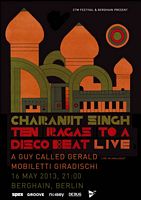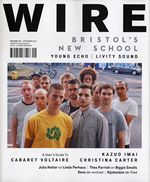 |
Polymorphism #6, CTM Festival, Berghain, Berlin, Germany Live Review |

|
The Wire Issue 355 September 2013 Page 77 |
Charanjit Singh + A Guy Called Gerald Before I was born, a Bollywood session man and wedding musician in Mumbai imported some Roland equipment and made a record called 10 Ragas To A Disco Beat, playing interpretations of traditional (ndian ragas on his new drum machines and synthesizers. It came off sounding more like Acid House than disco, except that it was made in 1982, more than a few years before the first Acid records were produced in Chicago. Perhaps unsurprisingly, it has been accused of being a hoax by some. Some 30 years later I'm stood in Kantine, the sister club to Berghain, and that wedding musician, Charanjit Singh, is playing live. Now in his mid-seventies and dressed in a black velvet jacket and matching silk shirt, he grins and wags his finger at a clutch of twenty-something German girls at the front, encouraging their dancing - "That's right! Keep it up!" Singh has an instrument which his photographer has nicknamed the "pew-pew machine", because of the sound it makes. It's a Mattel Synsonics drum machine with four drum pads on which he improvises dinky rhythms over the top of his loops, the details of which are written down in a notebook propped against a Roland synth. Each track is introduced with the name of the raga spelled out, what sort of raga it is, and when it should be played, but what follows is incongruous: massive Acid lines or beefy kick drum sounds that seem to bear little relation to the mood of a morning raga. As he becomes more immersed in his set, Singh nods, punches out more rhythms and looks out to the crowd for a response. Tracks are fiercely reimagined from their original versions on 10 Ragas To A Disco Beat, reworked with extra reverb and fatter riffs and arpeggios until they're thick like the atmosphere in the sweaty, blacked out room ("Everybody's sweating, I'm sweating, it don't matter, let's go on!" he shouts into the mic). Singh finds short, simple motifs and chases them, playing a couple of bars of keyboard licks over the top of a squirming synth line and singing into a vocoder. Singh is followed by A Guy Called Gerald, black sunglasses propped precariously on his forehead. He introduces his set by explaining he'll be playing "no vinyl, no nothing - this is purely analogue". Gerald's drum machines are harder than Singh's, with tighter snare patterns. But his music contains the same pace and moves along a similar trajectory. The restrictions of playing live on analogue equipment mean that both sets build slowly as only one thing can change at a time. A linear shifting of rhythms and sounds happens piece by piece, because the fundamentals are locked. This anchor means the pace of the night is under control, which, counter to expectations, actually comes as a relief: it's unlikely that there will be any dramatic timbral shifts or drastic tempo changes, as we're operating within a restricted set of expectations. While Gerald doesn't often play analogue-only sets, Singh's performance seems fresh, like he's excited to be playing live. His improvisations create variation around the basic grid set by his equipment and the raga forms, and this keeps things moving. Both musicians play for more than an hour (Gerald goes on for two), and neither run out of steam: their sets are anchored in repetition and restriction, but they're on a long enough chain to move freely. [Reviewer: Jennifer Lucy Allan] |
|